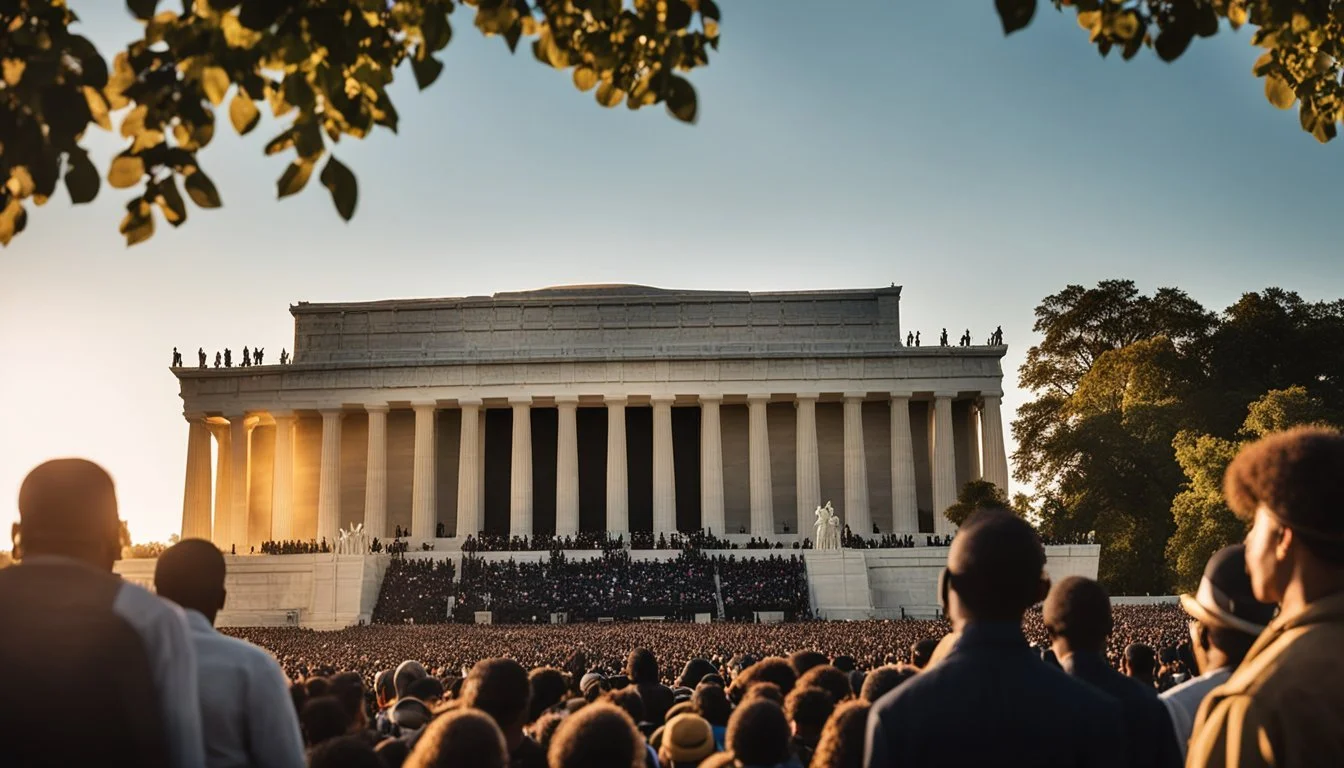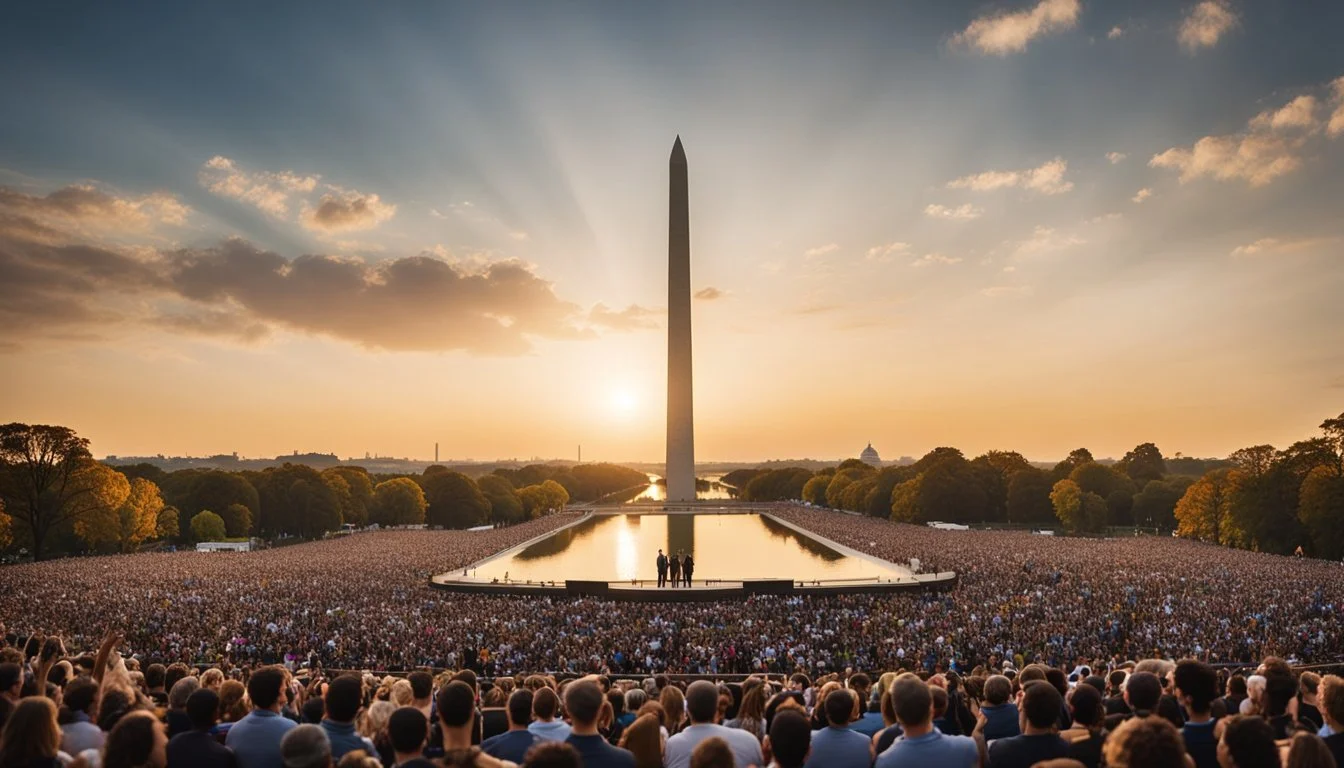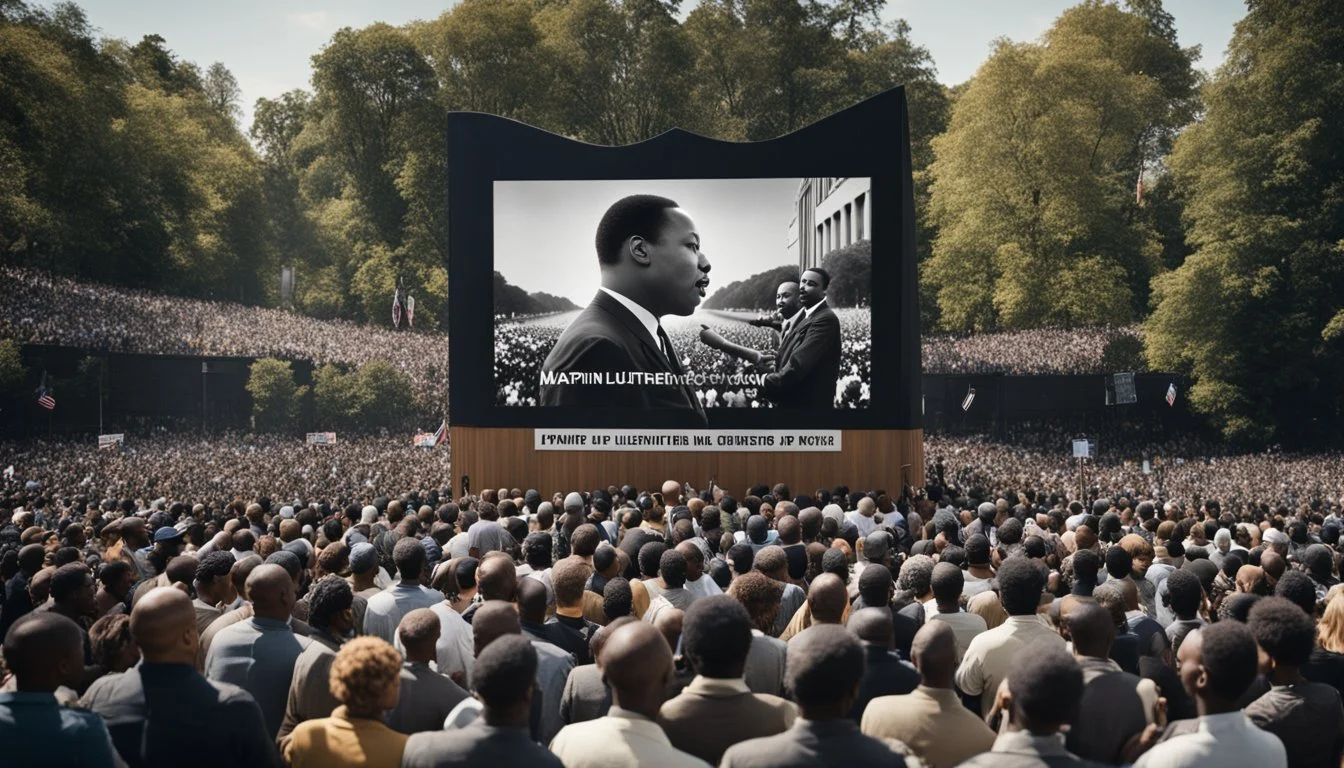7 Dream-Inspiring Films About Martin Luther King Jr.'s Famous Speech
Cinematic Tributes to "I Have a Dream"
Martin Luther King Jr.'s "I Have a Dream" speech remains one of the most influential orations in American history. Delivered on August 28, 1963, during the March on Washington for Jobs and Freedom, King's words continue to inspire generations with their powerful call for racial equality and justice.
Films about King's famous speech offer viewers a chance to explore its context, impact, and enduring legacy. These movies provide insights into the civil rights movement, the challenges faced by African Americans, and the visionary leadership of Dr. King. Through a blend of documentaries and dramatic retellings, audiences can gain a deeper understanding of this pivotal moment in history.
1) Selma (2014)
Selma depicts the historic 1965 voting rights marches from Selma to Montgomery, Alabama led by Dr. Martin Luther King Jr. The film focuses on the planning and execution of these pivotal demonstrations in the civil rights movement.
Director Ava DuVernay crafts a powerful portrayal of Dr. King and the challenges faced by activists. David Oyelowo delivers a compelling performance as the civil rights leader, capturing his charisma and conviction.
The movie showcases the strategic brilliance behind the marches, highlighting the careful organization required to combat systemic racism. It also portrays the brutality protesters endured, including the infamous "Bloody Sunday" on the Edmund Pettus Bridge.
Selma received critical acclaim for its historical accuracy and emotional impact. The film resonates with modern audiences, drawing parallels to ongoing struggles for equality and justice.
By focusing on a specific campaign, Selma offers a nuanced look at Dr. King's leadership and the complexities of the civil rights movement. It serves as both a tribute to past sacrifices and a call to continue the fight for equal rights.
2) King: A Filmed Record... Montgomery to Memphis (1970)
This powerful documentary chronicles the life and civil rights activism of Dr. Martin Luther King Jr. The film showcases King's journey from the Montgomery bus boycott to his tragic assassination in Memphis.
Directors Sidney Lumet and Joseph L. Mankiewicz crafted a compelling narrative using archival footage. The documentary captures key moments in the Civil Rights Movement, including King's iconic "I Have a Dream" speech.
Notable actors like Harry Belafonte, Ruby Dee, and Charlton Heston make appearances in the film. Their presence adds depth to the historical narrative.
At 185 minutes long, the documentary provides an in-depth look at King's nonviolent campaign for social and economic justice. It offers viewers a comprehensive understanding of his impact on American history.
The film's title reflects its scope, covering King's life from his early days in Montgomery to his final days in Memphis. It serves as a valuable historical record of one of the most influential figures of the 20th century.
3) Boycott (2001)
"Boycott" dramatizes the pivotal Montgomery Bus Boycott of 1955-1956. The film stars Jeffrey Wright as Dr. Martin Luther King Jr., depicting his emergence as a civil rights leader during this historic protest.
The movie focuses on King's role in organizing and sustaining the 381-day boycott. It portrays the challenges faced by the African American community and the strategic decisions made by King and other activists.
Wright's performance captures King's powerful oratory skills and his commitment to nonviolent resistance. The film showcases King's famous speeches from this period, including those that inspired the Montgomery community to persevere.
"Boycott" also highlights the contributions of other key figures like Rosa Parks and Ralph Abernathy. It provides insight into the personal sacrifices made by King and his family during this tumultuous time.
The film effectively illustrates how the Montgomery Bus Boycott laid the groundwork for King's future campaigns and speeches, including his iconic "I Have a Dream" address.
More information about "Boycott" on IMDb
4) The Witness: From the Balcony of Room 306 (2008)
"The Witness: From the Balcony of Room 306" offers a unique perspective on Martin Luther King Jr.'s final moments. This documentary short film, directed by Adam Pertofsky, focuses on the recollections of Reverend Samuel "Billy" Kyles.
Kyles was present on the balcony of the Lorraine Motel in Memphis when King was assassinated. The film provides a firsthand account of the events leading up to and including April 4, 1968.
Through Kyles' narrative, viewers gain insight into King's last days and the impact of his death. The documentary explores themes of service, justice, and equality that were central to King's mission.
Produced for the National Civil Rights Museum, "The Witness" serves as an educational tool. It helps preserve the memory of King's work and legacy for future generations.
The film received critical acclaim, earning an Oscar nomination for Best Documentary Short Subject at the 81st Academy Awards.
5) I Am MLK Jr. (2018)
"I Am MLK Jr." offers a comprehensive look at Martin Luther King Jr.'s life and legacy. This documentary features interviews with civil rights activists, politicians, and celebrities who reflect on King's impact.
The film explores King's famous "I Have a Dream" speech, providing context and analysis. It showcases rare footage of King delivering the speech at the March on Washington in 1963.
Directors John Barbisan and Michael Hamilton skillfully weave together archival footage and contemporary interviews. This approach highlights the enduring relevance of King's message in today's society.
"I Am MLK Jr." emphasizes King's commitment to nonviolent protest and his vision for racial equality. It also touches on lesser-known aspects of his work, including his efforts to combat poverty.
The documentary serves as both a historical record and a call to action for viewers to continue King's work. It reminds audiences of the power of King's words and the ongoing struggle for civil rights.
6) Our Friend, Martin (1999)
Our Friend, Martin is an animated educational film that brings Martin Luther King Jr.'s life and legacy to a young audience. The movie follows two middle school students who travel through time and meet Dr. King at various points in his life.
The film uses a blend of fantasy and historical facts to introduce children to key events in the Civil Rights Movement. It highlights Dr. King's famous "I Have a Dream" speech and its lasting impact on American society.
Our Friend, Martin features an impressive voice cast, including celebrities like Whoopi Goldberg, James Earl Jones, and Angela Bassett. This star-studded lineup helps bring the historical figures to life.
The movie's soundtrack incorporates Motown hits, adding a musical dimension that enhances the storytelling. Its educational value and emotional resonance earned it an Emmy nomination.
Our Friend, Martin serves as an accessible entry point for young viewers to learn about Dr. King's message of equality and nonviolence. It continues to be used in schools as a tool for teaching about the Civil Rights era.
More information on Our Friend, Martin
7) King in the Wilderness (2018)
King in the Wilderness offers a poignant look at the final years of Martin Luther King Jr.'s life. This HBO documentary focuses on the period between 1965 and 1968, revealing lesser-known aspects of King's journey.
The film explores King's struggles with criticism from both allies and opponents as he continued his fight for civil rights. It delves into his efforts to combat poverty and his opposition to the Vietnam War.
Through interviews with King's inner circle and rare archival footage, the documentary paints a complex portrait of a leader facing immense challenges. It sheds light on King's personal doubts and the toll his work took on him.
King in the Wilderness provides valuable insights into Dr. King's evolving vision and the difficulties he faced in his later years. The film earned critical acclaim and won an Emmy Award for Outstanding Historical Documentary.
More information on King in the Wilderness
Historical Context of Martin Luther King Jr.'s Speech
King's "I Have a Dream" speech emerged from the tumultuous civil rights struggle of the 1950s and 1960s. It came at a pivotal moment when the movement was gaining national attention and momentum.
The Civil Rights Movement
The civil rights movement aimed to end racial discrimination and segregation in the United States. African Americans faced widespread inequality, including segregated schools, restaurants, and public facilities.
Activists used nonviolent protests, boycotts, and legal challenges to fight for equal rights. Key events included:
1954: Brown v. Board of Education ruling against school segregation
1955-1956: Montgomery Bus Boycott led by King
1960: Sit-ins at segregated lunch counters
1961: Freedom Rides to integrate interstate bus travel
These efforts faced violent opposition in many areas, especially in the South. Television coverage brought images of brutality against peaceful protesters into American homes.
The March on Washington
The March on Washington for Jobs and Freedom took place on August 28, 1963. Over 200,000 people gathered at the Lincoln Memorial to demand civil and economic rights for African Americans.
Key details of the march:
Organized by civil rights, labor, and religious organizations
Supported by President Kennedy but opposed by some politicians
Featured speeches by civil rights leaders and performances by musicians
Culminated in King's famous address from the steps of the Lincoln Memorial
The march aimed to pressure Congress to pass civil rights legislation. It became one of the largest political rallies in U.S. history and a defining moment of the civil rights movement.
Impact of Martin Luther King Jr.'s Speech
Martin Luther King Jr.'s "I Have a Dream" speech catalyzed the civil rights movement and left an indelible mark on American society. Its powerful message reverberated through policy corridors and reshaped cultural attitudes across the nation.
Influence on Policy Changes
The speech played a pivotal role in advancing civil rights legislation. It helped build momentum for the Civil Rights Act of 1964, which prohibited discrimination based on race, color, religion, sex, or national origin.
The Voting Rights Act of 1965 followed, addressing racial discrimination in voting. King's words inspired lawmakers and activists to push for these landmark bills.
His vision of racial equality influenced housing policies as well. The Fair Housing Act of 1968 banned discrimination in housing sales and rentals.
Cultural and Social Impact
King's speech resonated deeply with the American public, shifting perspectives on racial issues. It became a touchstone for discussions about equality and justice.
The phrase "I have a dream" entered the national lexicon, symbolizing hope and aspiration. Schools began teaching the speech, ensuring its message reached new generations.
In popular culture, the speech inspired countless works of art, literature, and music. It continues to be referenced in films, songs, and political discourse.
The speech's impact extended globally, influencing civil rights movements in other countries. It remains a powerful symbol of non-violent resistance and the fight for human rights worldwide.
Analyzing Martin Luther King Jr.'s Rhetorical Techniques
Martin Luther King Jr.'s "I Have a Dream" speech employed powerful rhetorical devices to convey his message of racial equality and justice. His masterful use of language and delivery captivated audiences and continues to inspire generations.
Use of Repetition and Metaphors
King utilized repetition throughout his speech to emphasize key points and create a rhythmic, memorable quality. The phrase "I have a dream" was repeated eight times, driving home his vision for a better future.
He also employed anaphora, beginning consecutive sentences with the same words. Examples include "Now is the time" and "We can never be satisfied."
Metaphors enriched King's speech with vivid imagery. He compared the struggle for civil rights to cashing a check, stating that America had defaulted on its promise of equality.
King used the metaphor of "sweltering summer of the Negro's legitimate discontent" to describe racial injustice, contrasting it with the "invigorating autumn of freedom and equality."
Emotive Language
King's speech resonated deeply due to his use of emotive language that appealed to listeners' hearts and minds. He spoke of "flames of withering injustice" and the "fierce urgency of now" to convey the pressing need for change.
His words painted a picture of hope and unity, describing his dream of children joining hands "as sisters and brothers." This imagery evoked strong emotional responses from the audience.
King also employed alliteration to create a musical quality in his speech. Phrases like "dignity and discipline" and "trials and tribulations" added to the speech's poetic nature.
By appealing to shared American values and ideals, King made his message relatable to a wide audience. He referenced the Declaration of Independence and the Constitution, connecting the civil rights movement to the nation's founding principles.



